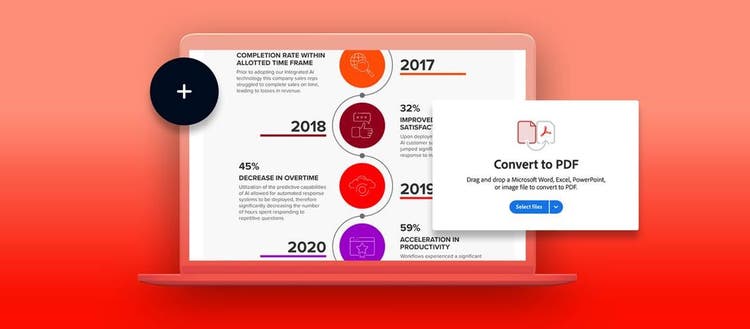PDFs and Acrobat online tools: A graphic designer’s dynamic duo

When it comes to graphic design, PDF files are not the first file format that comes to mind. JPG files tend to be more versatile when it comes to editing and manipulating images, so why would you bother to convert a JPG to a PDF? Dig a little deeper, however, and it becomes apparent that PDF files should be an integral part of any graphic artist’s toolkit. With PDF image files, you can:
- Display your work without distortion
- Provide end-users with an easy-to-print, lossless format
- Engage in real-time project collaboration
- Add PDF security to your images
When to use PDF files for design work
While it makes sense to use your favorite image editing software to manipulate an image, once your creation is ready, converting it to PDF can streamline other design tasks.
One of the great strengths of a PDF file is its ability to present all types of content, from brochures and spreadsheets to photos and artistic creations. According to 99designs, a Vistaprint publication, PDF is also a preferred format for printing finished work given its widespread use.
In general, bigger is better when it comes to using PDF files. It’s not usually practical to convert a small JPG of a logo or website icon into a PDF, but larger creations such as brochures, posters, and flyers are ideal as PDF files, enabling others to view, download, and print your creations with ease.
Simplify file sharing and project collaboration with Acrobat
Adobe Acrobat online tools are great for post-edit graphic design work such as image conversion, asking clients for feedback, and securing your work with password protection. You can try Acrobat tools once for free to begin working with your images in PDF. If you want more flexibility or if you’re juggling multiple digital imagery projects, start a seven-day free Acrobat trial to get unlimited use of the online tools and more advanced desktop tools.
Convert a JPG to PDF
To understand why you might want to convert an image to PDF, it’s important to understand the difference between JPG and PDF files. A JPG file is often used to post online images, as they reduce file size using a data compression system known as lossy compression. The lossy compression algorithm removes any data from the image it thinks isn’t essential. While this makes a JPG a compact, useful little file, it results in a loss of image quality.
When you convert a JPG to PDF, you often end up with a larger file, but one that doesn’t remove data or distort the original image, which can happen to a JPG. Your image can be viewed and copied without losing any detail if you convert it to a PDF file. Try the JPG to PDF online tool to see how well PDFs preserve the integrity of your work.
Collaborate in real time
Whether you’re designing an image for a graphic arts class or working with a client, you need a way to efficiently receive feedback. Use the Acrobat online Edit PDF tool to add your own comments and highlights to a PDF image file. You can even incorporate drawings into your PDF to share editing ideas without having to make time-consuming changes to the original file. Then sign into Acrobat online and use the Send for Comments tool to collect feedback from all other stakeholders. Reviewers can see and respond to each other’s comments, making it quick and easy to get everyone on the same page.
Protect your intellectual property
It’s always important to safeguard your work when dealing with clients and prospective collaborative partners. The Acrobat Protect PDF tool allows you to add a password to a file to restrict access, reducing the risk of your hard work falling into the wrong hands. The Protect PDF tool also adds an extra level of security by encrypting all password-protected files, helping to safeguard your creative property.
As you can see, PDF is often an ideal format for graphic artists. By using PDF files, you can disseminate your creative property securely without risking the loss of detail. At the same time, you can provide clients and partners the opportunity to collaborate and comment on projects with ease. Explore Acrobat online tools today to see how PDF can improve how you send, share, and collaborate on graphic design projects like never before.